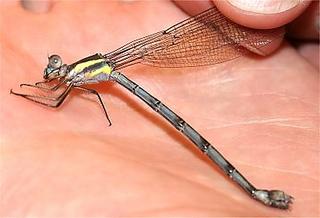
Remember back in July, when I said one of our goals was to find Great Spreadwing, Archilestes grandis, in Michigan? On 27 September, we did.
We've been looking for this brawny bug for a couple of years; it's a southwestern species that has been expanding its range since the 1920s. It was first found in southwest Ontario in 2002, although it has been present in Ohio since 1925. The other day, Stylurus and I met in northwestern Wayne Co. for dinner. It was a fairly new restaurant, part of a ~35 ac (~15 ha), as-yet unfinished development. A small creek emerged from a metal culvert under the busy road out front and went right between the restaurant and the parking lot, heading off to the rear of the development. The creek is perhaps 1 meter across, and the "protected natural wet land" (according to the sign; sic, and sick) is about 4 meters wide, full of weeds, trash, etc.
 It was a beautiful day, the last really warm day of summer. We crossed over the decorative little bridge, and a flash of substantial odonata wings caught our attention. I literally skidded to a stop, thinking it might be a late ovipositing Aeshna working the creek. But no, perched on a poorly planted (and therefore mostly dead) shrub was an enormous female spreadwing.
It was a beautiful day, the last really warm day of summer. We crossed over the decorative little bridge, and a flash of substantial odonata wings caught our attention. I literally skidded to a stop, thinking it might be a late ovipositing Aeshna working the creek. But no, perched on a poorly planted (and therefore mostly dead) shrub was an enormous female spreadwing."Wow," I said...I think out loud, "that has to be Archilestes grandis!"
"There's another!" Stylurus pointed out a male.
This was a little too unlikely, I thought. "They must be Amber-wings," I said, referring to the next-largest spreadwing, Lestes eurinus, still staring dreamily at the perched female. I knew as I said it this was not true.
Of course, we both had nets in the car, and I went ahead and caught the female. No doubt, here it was: Michigan's first Great Spreadwing.
Dinner abandoned for the time being, we walked along the creek for about a quarter-mile. The swath of green was never more than 5 meters or so wide, bordered by erosion cloth and then denuded ground with a covering of opportunistic weeds. The creek itself was rarely visible. Along most of the length were piles of twisted brush, thick growths of thistles, burdocks, buckthorn, and pioneering patches of Purple Loosestrife: an excellent example of Michigan's fantastic wetland protection and mitigation laws in action. There were five or so places where bridges leading to nowhere (but soon, office buildings) had been built over the creek, offering glimpses on either side of various types of garbage, and about five or six other Great Spreadwings. We caught a male for a second voucher. The sun was waning and we went back to the restaurant for a celebratory meal.
Yesterday afternoon it was still fairly warm but a strong cold front was approaching. I returned to try to census the population along the creek and take some photos. By the time I arrived it was cloudy with a strong wind. Hunkering low in the vegetation I located two pairs of Archilestes in tandem, and another six solo males. I would say that there are probably at least two or three dozen individuals along the creek, and that this is likely an established population. How long it will persist as the area becomes more degraded is anybody's guess. This species is tolerant of disturbed areas, but if the creek gets completely overgrown, polluted from runoff from the parking lots, full of algae from fertilizer or other nutrients such as abundant goose poop from the retention basin feeding it, or the flow gets obstructed from all the trash, then it may not longer be suitable habitat for this very grand Great Spreadwing.

(images clickable)






